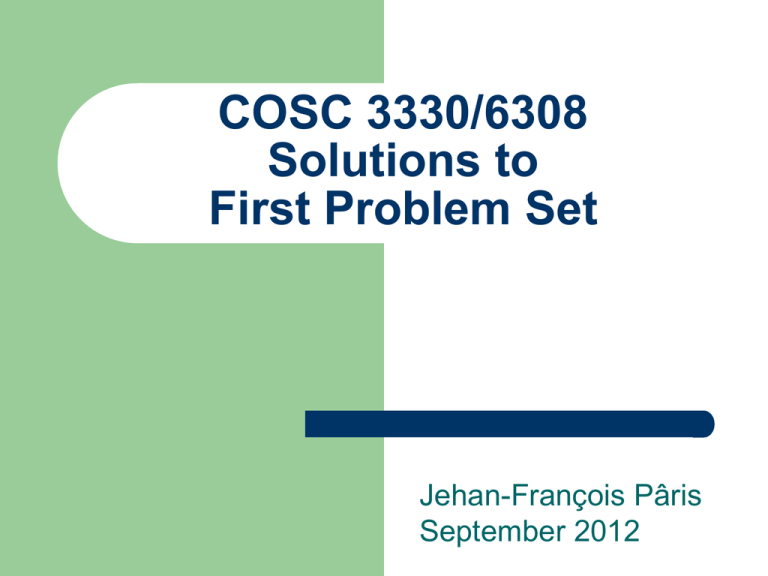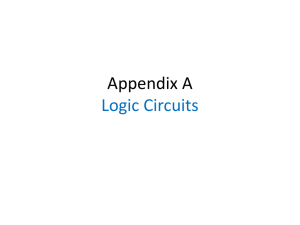COSC 3330/6308 Solutions to First Problem Set
advertisement

COSC 3330/6308 Solutions to First Problem Set Jehan-François Pâris September 2012 First problem (I) A program consists of two parts, namely – One part is purely sequential and takes 64 s to complete – Another part takes 1,024 s when run on a uniprocessor architecture Can be easily decomposed into two or more parallel tasks Speedup would be proportional to the number of tasks executing in parallel. First problem (II) What would be the speedups that the program would achieve if it was to run on computers with 2, 4, 8, 16, and 32 processors? What would be the maximum speedup that the program would achieve if it was to run on a computer with an unlimited number of processors? Answer (I) Will use Amdahl's law Tn To Speedup Tn Ti Answer (II) Sequential Number of Part (s) Proc. 64 1 64 2 64 4 64 8 64 16 64 32 Other Part (s) 1,024 512 256 128 64 32 Total (s) Speedup 1,088 576 320 192 128 96 NA 1.889 3.400 5.667 8.500 11.333 Second problem Simplify the two following logical expressions: – ABC'D' + AB'D' + ACD + CD – (A BC) (B + A) using both algebra and Karnaugh maps. First expression (I) ABC'D' + AB'D' + ACD + CD = ABC'D' + AB'D' + CD = ABC'D' + AB'D' + AB'C'D' + CD = AC'D' + AB'D' + CD First expression (II) C'D' C'D CD CD' A’B’ 0 0 1 0 A’B 0 0 1 0 AB 1 0 1 0 AB’ 1 0 1 1 AC'D' + AB'D' +CD Second expression (I) (A BC) (B + A) = (A(BC)' + A'BC) (A + B) = (AB' + AC' + A'BC) (A + B) = AB' + AC' + A'BC + ABC' = AB' +AC' +A'BC Second expression (II) BC A BC A B C A+ B PRODUCT F F F F F T F F F F F F F F F F T T F T F T F T T T F T T T T F F T F T F F F F T T T T T T T T T T T T T F T F A'BC AB'C' AB'C ABC' Second expression (III) B'C' B'C BC BC' A’ 0 0 1 0 A 1 1 0 1 AB' + AC' +A'BC Second expression (IV) A'B' A'B AB AB' C’ 0 0 1 1 C 0 1 0 1 AB' + AC' +A'BC Third problem Simplify the expression – (ABC)' (A + DE)' (A BC) (B + E) and convert it to a form that can be represented using a programmable logic array. Answer (I) (ABC)' (A + DE)' (A BC) (B + E) Let us do it in two parts – (ABC)' (A + DE)' = (A' + B' + C')(A'(DE)') = (A' + B' + C')(A'(D' +E') = A'(D' +E') + A'B'(D' +E') +A’C’(D’ +E’) = A'D' +A'E' Answer (II) The second part is – (A BC) (B + E) = (A(BC)' + A'BC)(B + E) = (AB' + AC' + A'BC)(B + E) = ABC' + A'BC + AB'E + AC'E + A'BCE Answer (III) The product is – (A'D' +A'E') (ABC' + A'BC + AB'E + AC'E + A'BCE) = A'BCD' + A'BCE' + A'BCD'E = A'BCD' + A'BCE' Sum of products can be represented by a PLA I checked the answer on a spreadsheet with 25 rows and 14 columns Fourth problem Implement the double implication operation: – A B = AB +A’B’ using only NAND gates. NAND gates A nand B = (AB)' = A' + B' nand (A) nand nand(B) = (A'B')' = A + B nand(A nand B) = (AB)'' = AB nand(nand(A) nand nand(B)) = (A' B')'' = A'B' Answer A A+B ((A + B)(A' + B')' = (A + B)' + (A' + B')' = A'B' +AB B A B A'+B' I started with a solution having more NANDs and simplified it Fifth problem Build a regular D flip-flop using an R’S’ latch, that is, an RS latch with inverted values for R and S, and as few NOR gates as possible. NOR gates A nor B = (A + B)' = A' B' nor (A) nor nor(B) = (A' + B')' = AB nor(A nor B) = (A+B)'' = A + B nor(nor(A) nor nor(B)) = (A' + B')'' = A' + B' From S'R' latch to D flip-flop S'R' has three inputs S' Q' – S' sets latch when S' = 0 R' Q and clock = 1 – R' resets latch when R' = 0 and clock = 1 Clock D flip-flop – Stores a 1 at clock transition when input is 1 – Stores a 0 at clock transition when input is 0 D flip-flop using an S-R latch X Clock S Q R Q' Clock D flip-flop using an S'-R' latch X Clock S' Q R' Q' Clock Introducing NORs X Clock S' Q R' Q' Clock (Clock+Clock')'=ClockClock' Note The solution is fairly simple because we assumed that the R'S' latch had a clock entry Solution for R'S' latch without clock input is more complex S’ Q R’ Q’ Sixth problem (I) Build a synchronous sequential circuit with – Two inputs, respectively named P—for plus—and M—for minus – Two outputs respectively named O—for overflow—and U—for underflow Sixth problem (II) The transitions are: P/00 P/00 000 P/10 010 001 M/00 P/00 M/00 M/00 M/01 M/00 M/00 111 100 101 P/00 P/00 M/00 M/00 110 P/00 011 P/00 Answer Eight states – Three flip-flops X Y Z Will consider separately – How P inputs affect X, Y, Z – How M inputs affect X, Y, Z – When counters outputs O and U How P inputs affect Z Y'Z' Y'Z YZ YZ' P'X' 0 1 1 0 P'X 0 1 1 0 PX 1 0 0 1 PX’ 1 0 0 1 Solution Z = P'Z + PZ' – Will use a T flip-flop triggered by P How P inputs affect Y Y'Z' Y'Z YZ YZ' P'X' 0 0 1 1 P'X 0 0 1 1 PX 0 1 0 1 PX’ 0 1 0 1 Solution Y = P'Y + PYZ' + PY'Z – Will use a T flip-flop triggered by PZ How P inputs affect X Y'Z' Y'Z YZ YZ' P'X' 0 0 0 0 P'X 1 1 1 1 PX 1 1 0 1 PX’ 0 0 1 0 Solution X = P'X + PXY' + PXZ' + PX'YZ – Will use a T flip-flop triggered by PYZ How M inputs affect Z Y'Z' Y'Z YZ YZ' M'X' 0 1 1 0 M'X 0 1 1 0 MX 1 0 0 1 MX’ 1 0 0 1 Solution Z = M'Z + MZ' – Will use a T flip-flop triggered by M How M inputs affect Y Y'Z' Y'Z YZ YZ' M'X' 0 0 1 1 M'X 0 0 1 1 MX 1 0 1 0 MX’ 1 0 1 0 Solution Y = M'Y + MYZ + M Y'Z' – Will use a T flip-flop triggered by MZ' How M inputs affect X Y'Z' Y'Z YZ YZ' M'X' 0 0 0 0 M'X 1 1 1 1 MX 0 1 1 1 MX’ 1 0 0 0 Solution X = M'X + MXY + MXZ +MX'Y'Z' – Will use a T flip-flop triggered by MY'Z' How P inputs affect O Y'Z' Y'Z YZ YZ' P'X' 0 0 0 0 P'X 0 0 0 0 PX 0 0 1 0 PX’ 1 0 0 0 Solution O = PXYZ How M inputs affect U Y'Z' Y'Z YZ YZ' M'X' 0 0 0 0 M'X 0 0 0 0 MX 0 0 0 0 MX’ 1 0 0 0 Solution U = MX'Y'Z' – Will use a T flip-flop triggered by MY'Z' Summary Flip-flops – Z: T flip-flop triggered by P + M – Y: T flip-flop triggered by PZ + MZ' – X: T flip-flop triggered by PYZ + MY'Z' Outputs – O = PXYZ – U = MX'Y'Z'







